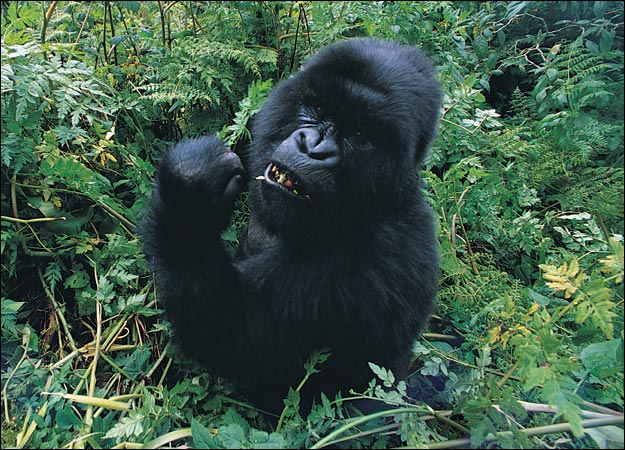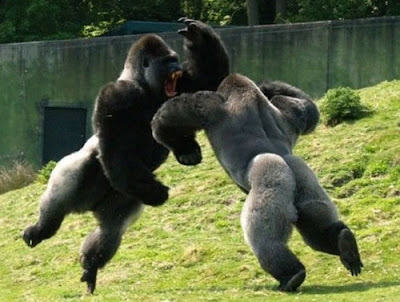
CLASSIFICATION
Kingdom: Animalia
Phylum: Chordata
Class: Mammalia
Order: Primates
Family: Hominidae
Genus species: Gorilla gorilla
Fish Photo Caption
GENERAL INFO
The male gorilla weighs on average in the wild about 180 kg
and stands almost 6 feet tall. The females are about half the weight and
stand only about 5 feet tall. The males with a larger body size
and bigger canines have more physical and sociable power in the groups
they are with. The average gorilla life span is between 35 and 50
years old.
The Gorillas typically have no predators because of their great
size, and the location they live in makes them one of the bigger animals
in that region. They are only around 650 mountain gorillas, and
40,000 lowland gorillas left in the world.
SPECIAL FEATURES
- to avoid confrontation when threatened, Gorillas
"yawn" to show their large canine teeth or beat their
chest while hooting or barking.
- The male gorillas will fight for dominance in the group to
become an alpha male and for mates.
- The Gorillas communicate by using calls, facial expressions,
and physical posture.

HABITAT
Western Gorillas inhabit the equatorial forests of Africa. These
gorillas are found in Africa's second tropical canopy.
DIET
Wild Gorillas are herbivores, and their diet consists mainly of juicy
stemmed plants. In addition, they will also eat leaves, berries, ferns,
and fibrous bark. Gorillas typically eat during the morning and
afternoon. Western Gorillas can climb trees up to 15 meters to
find food. The fast regrowth of vegetation allows Gorillas to live
in a relatively small area.
REPRODUCTION
The Gorillas are in groups and the Alpha male mates with the females
of the group. The females mate with the alpha males, because of
their superior fighting ability and more preferred to protect the
offspring. There is no certain breeding season for gorillas. At 10
years old the females give birth in 4 year intervals and nurse the
babies for 3 to 4 years. The males rarely mate before the age of
15 because of the physical competition for a mate.

HUMAN IMPACT
The gorilla faces many threats from humans in the wild. They
include slash-and-burn forest clearing, illegal hunting and trophy
poaching. The Gorilla existence is slowly starting the fall.

SOURCES
http://animaldiversity.ummz.umich.edu/site/accounts/information/Gorilla_gorilla.html
http://www.kilimanjaro.com/gorilla/
http://www.ohiostatepress.org/Books/Book%20Images/Lyttle-Gorillas-Gorilla-3.jpg
http://animal.discovery.com/mammals/gorilla/
http://blog.foreignpolicy.com/files/images/baby-gorilla.jpg
http://4.bp.blogspot.com/_IggDBj_gMTg/SdWeL7I1UpI/AAAAAAAAA8o/FoCGasjS1k4/s400/gorillafight.jpg
|



